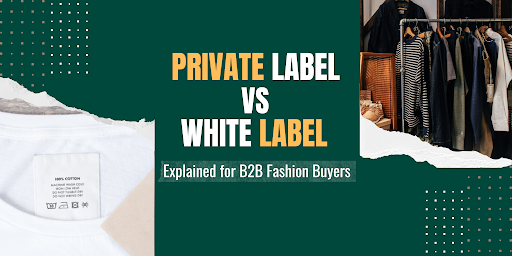Private Label vs White Label: Explained for B2B Fashion Buyers
22 July 2025

22 July 2025

Confused about private label vs white label fashion? You’re not alone. For B2B fashion buyers, the distinction can directly impact margins, inventory control, and brand equity. Whether you’re sourcing for a boutique, online store, or chain outlet, knowing the differences could save you serious time and money.
In this guide, we’ll break down the key definitions, advantages, and trade-offs. Then, we’ll show you how your sourcing strategy should align with your business model – and where a wholesale off-price distributor like Take Off fits in.
White label fashion refers to generic, unbranded products manufactured by one company and sold under another company’s label. The products are typically mass-produced and made available to multiple resellers with minimal changes.
Think of it like stock clothing where your brand gets slapped onto a tag. There’s no design input from your side – just fast access to resale-ready items.
Typical use case: A dropshipping e-commerce store that needs fast-moving fashion inventory with minimal setup.
White label fashion is often favored by startups or small-scale retailers who want to enter the market quickly without the burden of product development. You can focus on marketing, audience building, and customer service while relying on existing supply chains for your products.
Private label fashion involves a retailer working with a manufacturer to create custom designs under their own brand. You might tweak the fabric, fits, or features – and the product is usually exclusive to you.
This approach offers more control and brand consistency but also requires larger MOQs (minimum order quantities), longer lead times, and often comes with higher costs.
Typical use case: A boutique or multi-store operator launching a unique seasonal line with custom details and branding.
Private label gives retailers full control over product design and branding, helping them respond to trends, build a distinct identity, and foster long-term customer loyalty.
Here’s how the two compare:
| Feature | White Label | Private Label |
| Product Customization | Minimal – only branding | High – fabric, fit, design |
| Exclusivity | Shared with many sellers | Exclusive to you |
| Time to Market | Fast (1–3 weeks) | Medium to slow (6–12 weeks) |
| MOQ (Minimum Order Quantity) | Low (starting at 10–20 units) | High (100–500+) |
| Brand Equity | Low – generic feel | High – brand consistency |
| Logistics Support | Often limited | Buyer responsibility |
| Best For | New sellers, low budget, fast testing | Established brands, custom line builders |
Take Off, by contrast, provides immediate access to branded, off-price inventory from over 250 fashion labels. It’s ideal for B2B buyers who want curated, ready-to-ship collections without engaging in product development or manufacturing.
With multilingual support, full logistics handling, and flexible volumes, Take Off serves a different but highly valuable sourcing need.
Learn more about how Take Off simplifies exclusive European wholesale fashion in this detailed overview.
Pros:
Cons:
Pros:
Cons:
At Take Off, we specialize in off-price B2B wholesale distribution, not private or white label production. Why?
Because our clients don’t need to reinvent the wheel – they need access to high-quality, branded excess inventory they can move fast.
Our model gives you:
We help our buyers get fashion inventory in motion – without waiting months to build custom collections.
This makes Take Off ideal for retailers focused on agility, cost-efficiency, and selling proven products with brand recognition.
Choose white label if:
Choose private label if:
Choose Take Off if:
Not every retailer needs to build from scratch. In many cases, sourcing off-price branded inventory is a faster, smarter way to grow revenue.
Our clients often:
Off-price inventory also allows retailers to reduce time-to-market without compromising on quality. With Take Off’s curated collections, businesses can access stock aligned with their delivery calendar and maximize turnover without upfront design risk.
Learn how sourcing surplus fashion stock smartly with Take Off can improve your margins and inventory efficiency.
We don’t offer custom designs – but we do offer:
We’re not a trend-focused platform. Instead, we focus on practical stock planning, clean logistics, and personalized support.
Learn more about Take Off’s approach to non-trend tagged fashion stock and smart sourcing here.
Whether you run a boutique, manage a chain of stores, or sell through an e-commerce platform, Take Off is built to support every stage of the wholesale buying journey.
We also help reduce operational complexity by handling freight tracking, export documentation, and phased delivery logistics, making us a long-term sourcing partner for growth-focused retailers.
What is the difference between private and white label in clothing?
White label means reselling generic products under your brand. Private label involves custom designing and exclusive ownership.
Is white label cheaper than private label?
Yes – white label has lower startup costs and faster time-to-market.
Does Take Off offer private label or white label fashion?
No. Take Off provides branded excess inventory for B2B buyers, not custom manufacturing.
What if I only need 300 units?
Use our Bundlex platform to browse smaller collections.
Do you ship internationally?
Yes. We ship to over 60 countries and provide full customs documentation.